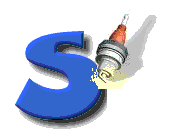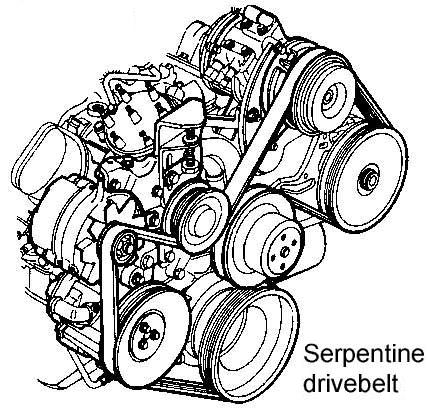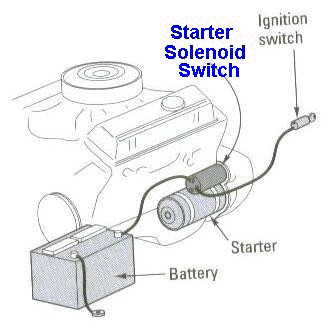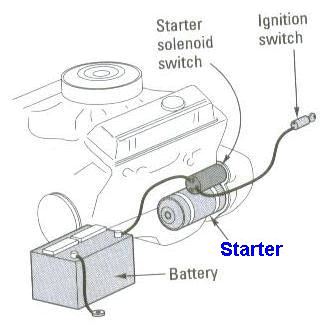|

SAE
Acronym for the Society of Automotive Engineers. A professional
organization that sets standards for measuring horsepower and torque
and for many automotive products such as fasteners, lenses, and lubricants.
Seal
[1]
A flexible ring, disc or washer that prevents the passage of liquid,
air, gas or dirt.
[2]
To prevent the passage of liquid, air, gas, etc. by means of a seal
or sealant (e.g., on seams, joints, flanges).
[3]
to coat a surface (e.g., when undersealing a car) by closing the
pores of the anodic oxide layer in order to increase the resistance
to staining and its effectiveness against corrosion
Sealant
A liquid or paste used to prevent leakage at a joint. Sometimes used
in conjunction with a gasket.
Sealed
Beam Lamp An older headlight design which integrates the
reflector, lens and filaments into a hermetically-sealed one-piece
unit. When a filament burns out or the lens cracks, the entire unit
is simply replaced.
Secondary
Winding
An inner winding of the ignition
coil; typically 20,000 to 30,000 turns of very fine wire.
The opposite is primary
winding
secondary
winding uses fine wire;
the
primary winding is heavy wire
Secondary
Wire Secondary
Wires
The high voltage wire from the coil to the distributor tower and
from the tower to the spark plugs.
Second
Gear
A
middle gear which has a faster ratio than low gear, but slower than
high gear. It is used for climbing or descending steep hills
Self-Sealing
Tires A tire that is designed to seal a puncture and
prevent a slow leak. One popular design seals 90% of tread punctures
from nails, bolts or screws up to 3/16 inch in diameter. When a nail
punctures such a tire, it's coated with a sealant to prevent slow
leaks. When the nail is removed, it automatically pulls additional
sealant into the hole in the tire's tread, creating a permanent seal.
Also known as nail-guard tires.
Semi
Independent Suspension
Semi-Independent
Suspension A rear axle design with a torsionally flexible
crossmember, the wheels being located on trailing links
|
Serpentine
Drivebelt
A
single, long, wide accessory drivebelt that's used on some newer
vehicles to drive all the accessories, instead of a series of
smaller, shorter belts. Serpentine drivebelts are usually tensioned
by an automatic tensioner. |
 |
Shim
Thin spacer, commonly used to adjust the clearance or relative
positions between two parts. For example, shims inserted into or
under bucket tappets control valve clearances. Clearance is adjusted
by changing the thickness of the shim.
Shock Absorber
Shock
Absorbers A term used for what are really dampers. Fittings
used to absorb the energy that the wheels convey to the springs. The
dampers keep the springs from continuously rebounding. The majority
of shock absorbers are hydraulic.
At
least one shock absorber is found at each wheel.
Shock
Absorber Struts A strut is a structural piece designed to resist
pressure in the direction of its length. On typical "McPherson
Strut" use, the shock absorber is built into the strut. Most
shock absorber struts are hydraulic units. Like the hydraulic shock
struts, faulty units must be replaced as an assembly. Another similar
front suspension system is called the "hydraulic shock
strut." This strut serves as a shock absorber and replaces the
upper control arm. The coil spring, however, is located between the
lower control arm and the body structure instead of being mounted
directly on the strut.
Shocks
An abbreviation for "shock absorbers."
Side
Beam The operating principle of direct-acting hydraulic shock
absorbers is in forcing fluid through restricting openings in the
valves. This restricted flow serves to slow down and control rapid
movement in the car springs as they react to road irregularities.
Usually, fluid flow through the pistons is controlled by
spring-loaded valves and the hydraulic shock absorber automatically
adapts to the severity of the shock. If the axle moves slowly,
resistance to the flow of fluid will be light. If it is rapid or
violent, the resistance is stronger, since more time is required to
force fluid through the openings. By these actions and reactions, the
shock absorbers permit a soft ride over small bumps and provide firm
control over spring action for cushioning large bumps. The
double-acting units must be effective in both directions because
spring rebound can be almost as violent as the original action that
compressed the shock absorber.
Sleeve Valve
Consists
of metal sleeves located between the piston and cylinder wall. When
moved up and down, holes in the sleeves coincide with inlet and
exhaust parts to provide passage for the gases at the right time.
Slide
Hammer A special puller that screws into or hooks onto a
component such as a shaft or bearing; a heavy sliding handle on the
shaft bottoms against the end of the shaft to knock the component free.
Solenoid
|
1.
An elecrtomechanical device similar in operation to a relay,
however, the movement of the armature or iron core results in
changing electrical energy into mechanical energy.
2.
An electro-mechanical device used to effect a push-pull mechanical
operation using electrical current.
3.
A rely with an external mechanical movement.
An
electrically operated magnetic device used to operate some unit. A
movable iron core is placed inside a coil of wire which moves because
of magnetic attraction when electric current is fed to the coil. When
current flows through the coil, the core will attempt to center
itself in the coil. In so doing, the core will exert considerable
force on anything it is connected to.
|
See
clutch solenoid
fast idle solenoid
idle stop solenoid
starter solenoid
stop solenoid
throttle solenoid
vacuum solenoid |
|
|
|
Solenoid
Relay A relay that connects a solenoid to an electrical
circuit, such as a starter-motor solenoid relay.
Solenoid
Starter Switch A solenoid-operated starter motor switch

Solenoid
Switch An electrical switch that is opened and closed
mechanically by the movement of a solenoid core.
Solenoid Valve
A mechanical valve that is operated by a solenoid to control the
flow of a liquid or a gas. Used in braking systems, air conditioning
systems, emission control systems, cruise control systems and even
suspension and steering systems.
Spark
Plug A device inserted into the combustion chamber of a
cylinder on an internal-combustion engine that provides the
electrical gap across which the high-tension voltage jumps. This
creates a spark that ignites the compressed fuel-air mixture.
Spark
Plug Wires The spark plug wire carries 20,000 or more volts from
the distributor cap to the spark plug. Spark plug wires are made of
various layers of materials. The fiber core, inside the spark plug
wire carries the high voltage. Some spark plug wires have a locking
connection at the distributor cap. The distributor cap must first be
removed and the terminals squeezed together, and then the spark plug
wire can be removed from the distributor cap. To work effectively in
modern ignition systems, it is important that the resistor ignition
cable is capable of producing a specifically designed resistance.
Speedometer
and Odometer
The
analog speedometer that is used on cars indicates its speed and
records the distance the car has traveled. A speedometer is driven by
a flexible cable connected to the speedometer pinion in the
transmission. Speedometers are calibrated in miles per hour and/or in
kilometers. The instrument records the distance traveled in miles or
kilometers. That portion of the instrument is known as the odometer.
Most odometers record the total distance traveled. Some also record
the distance of individual trips.
Spoiler
A spoiler is a kind of wing that is mounted on the rear of the
car in a horizontal position. Its function is to provide high-speed
stability. In most cars, the spoiler is purely cosmetic, as a car has
to be going over 100 mph to take advantage of the aerodynamics of the
spoiler. Some mini-vans also make use of a spoiler, but it's upside
down, and angled. This type of a rear spoiler only keeps the rain off
the rear window.
Springs
A device on the suspension
system to cushion and absorb shocks
and bumps and to keep the vehicle level on turns. After the stress or
pressure exerted by the flexing of the spring has been removed, the
spring returns to its original state. The spring does this by first
absorbing and then releasing a certain amount of energy. The form of
spring may be leaf springs,
coil springs,
torsion bars,
or a combination of these.
Springs
have life spans that are determined by the number of cycles they can
withstand over a certain period of time. If a spring breaks while a
car is being driven, the car will suddenly lurch downward. The bottom
of the car might be damaged, or you might lose your muffler! Leaf
springs are made of individual springs, or plates. If you break one
plate of your leaf spring, it won't be noticeable, but your car might
begin to lean to one side or the other. Coil springs, if they break,
will suddenly drop the front or rear end of your car and impair
driving under the normal conditions of full suspension travel.
Sprocket
A tooth or projection on the periphery of a wheel, shaped to engage
with a chain or drivebelt. Commonly used to refer to the sprocket
wheel itself.
Starter
A
small electrical motor that causes the engine crankshaft to begin to
turn, which starts the engine running and so starts the vehicle.
Invented in 1911 by Cadillac engineers, the manual crank-starter was
replaced by an electric motor and thus made it easier and safer for
people to start and drive cars.
Also
called the "cranking motor."

The
starter converts electricity to mechanical energy in two stages.
Turning on the ignition switch releases a small amount of power from
the battery to the solenoid above the starter. This creates a
magnetic field that pulls the solenoid plunger forward, forcing the
attached shift yoke to move the starter drive so that its pinion gear
meshes with the engine's crankshaft flywheel. When the plunger
completes its travels, it strikes a contact that permits a greater
amount of current to flow from the battery to the starter motor. The
motor then spins the drive and turns the meshed gears to provide
power to the crankshaft, which prepares each cylinder for ignition.
After the engine starts, the ignition key is released to break the
starting circuit. The solenoid's magnetic field collapses and the
return spring pulls the plunger back, automatically shutting off the
starter motor and disengaging the starter drive. When the starter is
not in use, the drive unit is retracted so that its pinion is
disengaged from the flywheel. As soon as the starter is activated,
the forward movement of the solenoid plunger causes the shift yoke to
move the drive in the opposite direction and engage the pinion and
flywheel. The pinion is locked to its shaft by a clutch that unlocks
if the engine starts up and the flywheel begins turning the pinion
faster than its normal speed. By allowing the pinion to spin freely
for a moment, the clutch protects the motor from damage until the
drive is retracted.
Starter
Circuit The starter circuit is activated when the ignition
switch is turned on, thereby opening a second switch in the solenoid,
permitting a second flow of electricity from the battery to the
starter motor. The engine cranking circuit is made up of a battery,
starting motor, ignition switch, and electrical wiring. On placing
the ignition switch in the "start" position, the solenoid
windings are energized and the resulting shift lever movement causes
the drive pinion gear to engage the flywheel ring gear, and cranking
takes place. When the engine starts, an overrunning clutch (part of
the drive assembly) protects the armature from too much speed until
the switch is opened. At this time, a return spring causes the pinion
gear to disengage from the flywheel.
Starter
Inhibitor Switch On vehicles with an automatic
transmission, a switch that prevents starting if the vehicle is not
in Neutral or Park.
Starter
Solenoid A magnetic switch, energize by the ignition
switch, that shifts the starter-drive pinion gear into the flywheel
ring gear, then closes the electric circuit to the starter.
Starter
Solenoid Switch see solenoid
starter switch
Stator:
[1]
A small hub, upon which a series of vanes are affixed in a radial
position, that is so placed that oil leaving the torque converter
turbine strikes the stator vanes and is redirected into the pump at
an angle conducive to high efficiency. The stator makes torque
multiplication possible. Torque multiplication is highest at stall
when the engine speed is at its highest and the turbine is standing still.
[2] The
stationary windings in an alternator in which electric current is
generated; located between drive end and slip-ring end fittings,
consisting of a stator frame with windings in three circuits to
generate three-phase current which is then rectified by diodes. Also
see ROTOR
[3] A
self-contained unit of the magnetic pick-up, consisting of a
permanent magnet, an inductive winding, and the pick-up core; the
stator can be a disc-shaped pole piece with stator tooth or a simple
pole piece
[4] The
wheel with curved blades (sometimes adjustable) mounted on a one-way
clutch in a fluid converter or automatic transmission. It serves as a
reaction member, i.e., it multiplies the torque output of the turbine
by increasing the momentum of the fluid flow acting on the latter.
[5] The
fixed electrical windings on a magneto, alternator, or generator. It
turns within the rotor.
Steam
Engine
An
external combustion engine where water is converted to steam in a
boiler outside the cylinder. The steam is then admitted to the
cylinder where it expands against a piston. As the steam expands it
cools and begins to condense. This mixture of water droplets and
steam is forced out of the cylinder on the return stroke and into the
condenser where the remaining steam is condensed into water. This
water is forced into the boiler by a pump and the cycle is repeated.
Steam engines have some notable drawbacks: slow warm up, freezing of
the water system in cold weather, and contamination of the water by
scale, oil, and sludge which can wreak havoc with the boiler, pumps,
and condenser. But they also offer certain advantages: the potential
for high fuel economy with low emissions, the ability to start from
rest against a load so a clutch is not needed, and the torque
developed is greatest at low rpm so in some applications a
multiple-ratio gearbox is not necessary.
Read
about The History of The Steam Engine
and
The
Automobile here
Steering
Arms The steering arms pick up motion from the relay rods and
the tie rods, causing the steering knuckles to turn the wheels. They
are not used in rack-and-pinion setups.
Steering
Systems
The
manual steering system incorporates:
1.
steering wheel and column,
2.
a manual gearbox and pitman arm or a rack and pinion assembly,
3.
linkages; steering knuckles and ball joints; and
the
wheel spindle assemblies. Power steering systems add a hydraulic
pump; fluid reservoir; hoses; lines; and either a power assist unit
mounted on, or integral with, a power steering gear assembly. There
are several different manual steering gears in current use. The
"rack and pinion" type is the choice of most manufacturers.
Stroke
The
back-and-forth motion of the piston. The length of the motion of the
piston from top dead center to bottom dead center.
Strut
The main support member in a MacPherson suspension system. The strut
also serves as the shock absorber.
Supercharger
An
air compressor fitted to an internal combustion engine to force the
fuel-air mixture into the cylinders at a pressure greater than that
of the atmosphere. Boosts the power of the engine.
Suspension
The
assembly of springs, shock
absorbers, torsion bars, joints, arms, etc., that
cushions the shock of bumps on the road and serves to keep the wheels
in constant contact with the road, thereby improving control and traction.
Suspension System
A
system that cushions the passenger compartment of the vehicle from
the bumps and shocks caused by the wheels moving over irregular road
surfaces. Includes springs, shock absorbers, steering linkage, upper
and lower control arms, torsion bars, stabilizers, etc. Sometimes
called "springing."
Sway
Bar Some cars require stabilizers to steady the chassis against
front-end roll and sway on turns. Stabilizers control this
centrifugal tendency that forces a rising action on the side toward
the inside of the turn. When the car turns and begins to lean over,
the sway bar uses the upward force on the outer wheel to lift on the
inner wheel, thus keeping the car more level.
Swing
Axle Type of independent rear suspension using half shafts
that have universal joints only at their inboard ends on both sides
of the differential. This causes a camber angle change of the wheel
with up-and-down wheel movements.

A
B
C
D
E
F
G
H
I J
K
L
M
N
O
P
Q
R
S
T
U
V W
X
Y
Z |